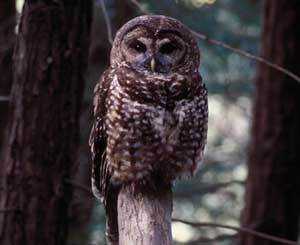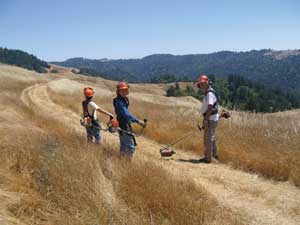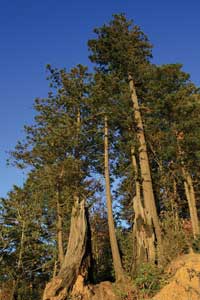It’s a Saturday morning at Freezeout Flat along the Russian River, just south of Duncans Mills. Thirty prospective park users have assembled to hear the terms of engagement here at Willow Creek, one of the newest pieces of California’s state park system. “You’re welcome to call us and report on what you see,” says Autumn Summers of the non-profit group LandPaths. “If there’s a tree down on a trail, we want to know about it, or if you see signs of motorcycles, or anything out of the ordinary.” The future stewards of the park—sensible gray-haired birders with folding camp chairs, young couples adjusting their baby carriers, and folks of all ages in between-await the one detail everyone writes down: the gate combination.
That’s their ticket to the 3,373 acres that the 2005 acquisition of Willow Creek added to the east side of Sonoma Coast State Park, along the Russian River. In one stroke, the purchase protected over 80 percent of the Willow Creek watershed. The land includes scraps of old-growth redwood and Douglas-fir, and high, rolling ridgetops with views made more spectacular by what they don’t include. To the west, nothing but rounded hills and the ocean floating beyond like a deeper shade of sky. To the east, layers of rockier ridges backed by Mount St. Helena. No buildings, no power lines, not even a ribbon of road, no engine sound unless a plane passes overhead. It seems impossible—Santa Rosa’s 160,000 people are 15 miles to the east, and Sonoma Coast State Beach receives 3.3 million visitors each year. At Willow Creek, hikers seldom encounter another human and usually find their vehicle the only one parked inside the locked gate at Freezeout Flat. It’s possible to walk the seven and a half miles to Shell Beach without seeing a car until the coast highway.
- The main public trail through Willow Creek leads to the “islands in thesky,” isolated stands of dense forest amid wide-open grasslands withextensive views, from the ocean in the west to Mount St. Helena in theeast. Photo by Galen Leeds.
Public access here at Willow Creek is an experiment whose success may well make it a model for future projects. It involves an unusual degree of cooperation between state park officials, LandPaths’ staff, funders at the Coastal Conservancy and the Sonoma County Agricultural Preservation and Open Space District, and most of all, the more than a thousand people who have gone out to Freezeout Flat to get a free access permit and become the eyes and ears that look after the place.
People have been walking through and watching over Willow Creek, without permits, for at least 13,000 years. It marked a friendly boundary between the Kashaya Pomo, whose territory extends up past Salt Point (20 miles to the north), and the southern Pomo, who lived between the Russian River and Cotati. The area was used regularly by both tribes and occasionally by the neighboring Coast Miwok, and it was part of a trail system that linked inland settlements near Cotati and Sebastopol with those along the Russian River and the coast. Native people gathered willows and other basketry materials, medicinal and food plants, and chert for tools. There were overnight camps for travelers and ceremonial gathering places with petroglyph boulders. After a recent visit to Willow Creek, Kashaya Pomo cultural resources officer Reno Franklin said, “As we were hiking up the hill, I thought, it’s amazing how many plants are on these ridgetops that we use for medicine and food—this is why we’re here.”
The first Europeans to settle here in coastal Sonoma County were Russian fur traders who arrived in 1812. After devastating the local populations of sea otters and fur seals, they tried farming wheat for export to Alaska. In 1833, after farming failed at foggy Fort Ross, they built barns and barracks along Willow Creek for an inland wheat farm known as the Kostrimitinov Ranch. At first, local native people provided the labor, but one year of industrial agriculture proved too much for them—the tribes disappeared into the hills and steered clear of the former fur traders. The desperate Russians then captured 160 Pomos to use as field slaves, but that only brought ongoing attacks from the captives’ relatives. The Russians abandoned the ranch in 1841, and the buildings were then dismantled for salvage. Later logging and resulting sedimentation has left the exact location of the farm a mystery to this day.
In 1846 commercial redwood logging began in Willow Creek. Cattle arrived in the wake of the lumberjacks, and the land remained a patchwork of logging and grazing for the next 150 years. The Willow Creek watershed combines steep upper slopes with very flat bottomland—the grade going into the Russian River is a virtually imperceptible two-tenths of one percent—so every upslope disturbance sends sediment down to the flats. Logging was most aggressive here during the 1960s and ’70s when the timber company Louisiana-Pacific owned the land, and a big 1983 storm moved untold tons of soil from logged hillsides down into the valley. This sedimentation has created challenges for both habitat restoration and archaeological research. Sonoma State University anthropologist Mike Newland is combing through the Willow Creek watershed this fall with a crew of students and tribal representatives, looking for any evidence of human activity, from ancient native camps to early logging artifacts to the Kostrimitinov Ranch. “It’s unlikely we’ll find the ranch,” he says. “You’ve got a lot of vegetation growing up out there on the sediment layers, and the root mass gets really thick.”
Sedimentation is also the challenge for habitat restoration here, which focuses on what state parks biologist Brendan O’Neill calls “ecosystem resiliency.” That translates to stopping sediment deposits at the source. Fifteen miles of logging roads have already been decommissioned, and the next phase of restoration will include establishing riparian cover in gullies, restoring bridges, removing blockages to fish passage, and adding large deadwood to the creek to create shelter for juvenile salmon. Willow Creek is, in fact, an excellent candidate for the reintroduction of coho, which have very precise temperature range requirements, because only minor changes are needed to make the creek into good habitat. The watershed’s remnant steelhead trout population would also benefit from these improvements.

- Spotted owls hunt dusky-footed woodrats in second-growthredwood and Douglas-fir forest, but they nest and pursue Sonoma treevoles in remnant patches of old growth. Willow Creek has a patchwork ofboth, putting “the bedroom next to the kitchen,” says one biologist.Photo by Charles Kennard.
Though coho have yet to return, Willow Creek is home to other threatened species, including the Sonoma tree vole and its predator the spotted owl. Tree voles spend their entire lives in one or two trees. They eat only Douglas-fir needles, drink condensed fog or raindrops depending on the season, and never set foot on the ground. Their presence can be detected by their nests—big piles of sticks high in the trees—and their middens, accumulations of fir needle resin ducts on the ground below. Spotted owls don’t depend entirely on tree voles in their diet; they also eat the much more plentiful woodrats that thrive in logged areas. That makes Willow Creek’s mosaic of habitats ideal for spotted owls. As Mendocino Redwood Company’s senior wildlife biologist Robert Douglas explains, at Willow Creek the spotted owls “have the bedroom next to the kitchen”—they nest in pockets of old growth and hunt woodrats in nearby logged areas. (In Oregon and Washington, it’s a different story: Spotted owls there require large tracts of old growth because they eat mostly flying squirrels, which require old growth for their dietary staple, truffles.)
But Willow Creek’s key wildlife habitat enhancement may not be its specialized niches for spotted owls and Sonoma tree voles, nor even its three miles of readily restored salmon stream. The acquisition was the big missing piece in what had been a patchwork of separate protected areas. Now the contiguous protected land totals 13,500 acres, spacious enough to support even those wild residents who need to roam, like cougars, bobcats, and black bears.
The story of how this especially marvelous piece of that puzzle came to be part of our state park system begins back in 1990 with passage of the ballot initiative that formed the Sonoma County Agricultural Preservation and Open Space District. Administered by the board of supervisors and aided by a citizen advisory committee, the district uses outright land purchases as well as conservation easements to preserve working farms and ranches, wild buffers between towns, endangered habitats and water sources, and recreational lands. Purchased land is turned over to partners such as the state park system. Without the open space district, the Willow Creek purchase might not have been possible.

- LandPaths volunteer coordinator Rebecca Thomsen (on left)has worked with over 100 volunteers to open and maintain the park. Thiscrew is mowing a path to the Islands in the Sky overlook. Photo by LandPaths Staff.
As often happens, one person held the vision for this land years before it materialized. In Willow Creek’s case that visionary was Carol Hart, who lived nearby and served on the district’s advisory committee. She also helped found LandPaths, which began in 1996 to manage a tiny but magnificent stand of virgin redwoods west of Occidental called the Grove of the Old Trees. In 1997 the group took on stewardship of the McCormick addition to Sugarloaf Ridge State Park east of Santa Rosa. When Louisiana-Pacific sold its timber holdings in Sonoma to the Mendocino Redwood Company in 1998, Hart asked Mendocino Redwood’s CEO Sandy Dean to sell the Willow Creek watershed to the state park system. Dean demurred, but Hart pressed the company to at least allow public recreational access to the property. Perhaps sensing the public relations potential of such a move, Dean agreed. LandPaths came up with a rudimentary process—send a deposit, get a key. The program created a core group of committed volunteers whose efforts proved invaluable in developing the current public access system.
In 2000 Dean told LandPaths that Mendocino Redwood Company was ready to sell. By that time, Hart sat on the State Parks Commission, but it still took five years of negotiations among an unusually large cast of characters to close the deal. LandPaths director Craig Anderson brought all partners to the table—”residential neighbors, folks in green from Sacramento, old ranchers, the tie-dye people—we tried really hard to work with everybody.” The Trust for Public Land acted as principal negotiator between Mendocino Redwood and the various government agencies involved in the nearly $21 million sale.
But state officials still hesitated to take responsibility for Willow Creek because their park maintenance budget had been so severely gutted—there was simply no money to plan, build, or maintain trails; install restrooms; pick up trash; or send rangers to patrol the new park. Here’s where LandPaths’ existing permit system and volunteer stewards saved the day. The Coastal Conservancy and the Open Space District each committed $300,000 to cover Willow Creek’s first four years as a state park, and that money now funds LandPaths’ Willow Creek activities, as well as the planning for future trails and amenities. It’s an incubator model for growing public access, and everyone involved hopes that, Willow Creek will be fully open to the public within five years.

- Loggers cut trees here as early as 1846, but the worstlogging occurred in the 1960s and ’70s. Today, young trees grow amongthe remains of their ancestors. Photo by Galen Leeds.
LandPaths holds orientation meetings at Willow Creek once or twice a month, for up to 40 people. “The truly remarkable thing, in this litigious, anxiety-ridden century,” Anderson says, “[is that] we’ve never had to change the gate combination.” Thanks to volunteer work days, the park has trail markers, a mowed parking area, a hitching post, and a bunker for horse manure. Jonathan Glass, Land-Paths’ field programs director, says volunteers are eager to do more: “As soon as we have authorization to go ahead with trail building, there are people just chomping at the bit to go out and do it.” Another level of engagement is the Trail Watch program, in which visitors fill in for overworked rangers. “It started out by necessity,” Anderson says, “but this idea of managing wildland with volunteers investing themselves in the place has morphed into a conscious design.”
School programs and guided group hikes are offered by Stewards of the Coast and Redwoods, a nonprofit organization that supports Russian River area state parks. A recent outing followed the Islands in the Sky loop trail, which climbs from the parking area up past creekside redwood, bay, and alder underlain with massive stands of thimbleberry, to open grasslands and the “island” trees of the trail’s name. These ridgetop groves are fronted by ancient sentinel firs that lean toward the ocean with four-foot-diameter horizontal branches wearing dense mats of leather fern. Their top-of-the-world shelter is irresistible, shaded and breezy in summer and dry in winter, with views from here to everywhere. Thanks to the efforts of a great many folks, we can take our turn in the long procession of travelers to pause here and gaze over wild rolling hills to the Pacific.
Getting there:
Access to Willow Creek-on Freezeout Road, just off Highway 116 south of Duncans Mills-is restricted, so plan to attend a guided walk held by the Stewards of the Coast and Redwoods (first Saturdays, May through October); Stewards of the Coast and Redwoods, or (707)869-9177. For permit information, contact LandPaths at (707)524-9318.

.jpg)




